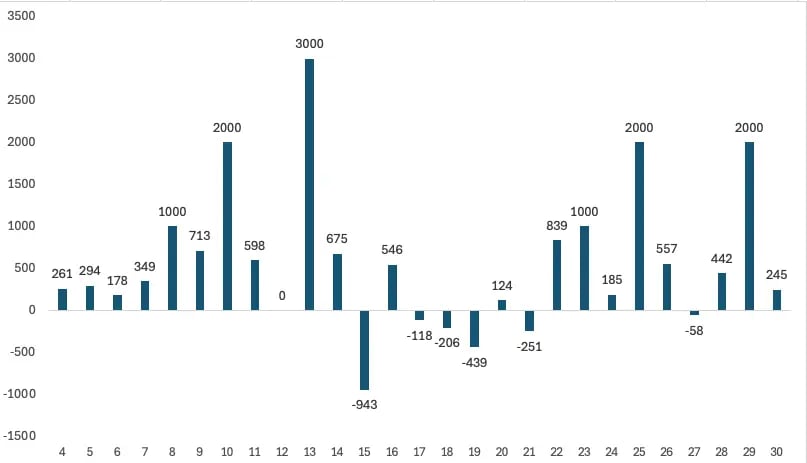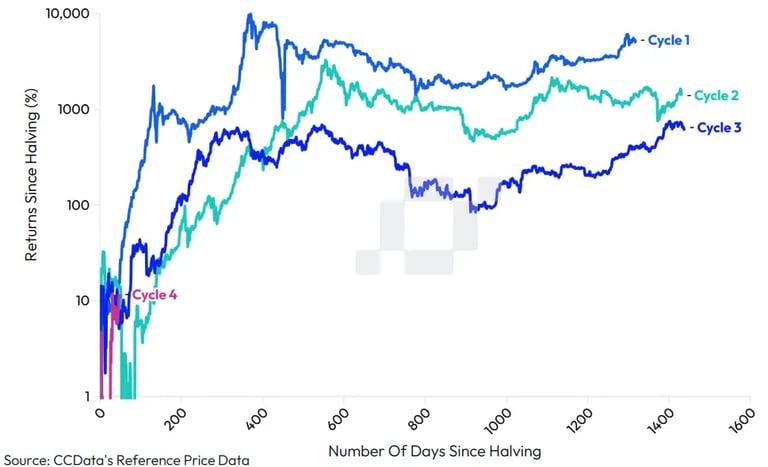Spot ETF surge: Investor Behaviour and Election Impact
Rishabh Nagar
8/1/20248 min read
TL; DR
Massive Inflows to Spot Ethereum ETFs: U.S. spot Ethereum ETFs launched with significant net inflows, led by BlackRock's ETHA with $500.2 million, followed by Bitwise’s ETHW ($276.3 million) and Fidelity’s FETH ($244.2 million).
Spot ETFs Dominate: Spot Ethereum ETFs now account for 99.3% of Ethereum ETF trading volume, surpassing the 92.7% market share of spot Bitcoin ETFs over futures.
Surging Digital Asset Trading Volumes: Digital asset investment products saw $245 million in inflows last week, with trading volumes hitting $14.8 billion, the highest since May, and total assets under management reaching $99.1 billion.
Blue Rabbit Learn Study: Blue Rabbit's analysis highlights that by 2024, 40% of U.S. adults are expected to own crypto, potentially adding 32.7 million voters. This demographic could play a crucial role in a closely contested election. Read below to know more about how this could sway the results.
Introduction
Ethereum Exchange-Traded Funds (ETFs) are an innovative financial product designed to provide investors with exposure to Ethereum (ETH), the second-largest cryptocurrency by market capitalization, without the complexities and risks associated with directly purchasing and storing ETH. These ETFs are traded on traditional stock exchanges and aim to replicate the price performance of Ethereum, making it accessible to a broader range of investors.
Understanding Spot Ethereum ETFs
A spot Ethereum ETF is a type of exchange-traded fund that directly holds Ethereum and aims to track its market price as closely as possible. Unlike futures-based ETFs, which derive their value from derivatives contracts, spot ETFs are backed by actual holdings of Ethereum.
Key Features of Spot Ethereum ETFs
Direct Ownership of ETH: The primary characteristic of a spot ETF is that it holds physical Ethereum. This means the fund’s value is directly tied to the price movements of Ethereum on the open market.
Transparency: Spot ETFs are designed to provide transparency to investors regarding their holdings. Regular disclosures about the quantity of ETH held and its value are made to maintain investor confidence.
Regulatory Compliance: Spot ETFs operate under the regulatory frameworks of the jurisdictions in which they are listed, ensuring that they adhere to financial regulations and provide a safe investment vehicle.
Market Impact: The introduction of spot Ethereum ETFs can have a significant impact on the cryptocurrency market. By providing a regulated and accessible way to invest in Ethereum, these ETFs can attract institutional and retail investors, potentially increasing market liquidity and stability.
Eth ETF Money Flow
The launch of U.S. spot Ethereum (ETH) exchange-traded funds (ETFs) marked a significant milestone in the cryptocurrency investment landscape. Last week, nine new spot Ethereum ETFs from eight different issuers commenced trading after receiving approval from the Securities and Exchange Commission in May. These ETFs have quickly attracted investor attention, although the fund flows have shown contrasting patterns.
Fig.1 - Total Ethereum Spot ETF Net Inflow USD
Source: Coinglass
Leading the pack, BlackRock's ETHA attracted a notable $500.2 million in net inflows within the first week of trading. This was followed by substantial inflows into Bitwise’s ETHW ($276.3 million) and Fidelity’s FETH ($244.2 million). Other ETFs also saw positive net inflows: VanEck’s ETHV ($46.3 million), Franklin Templeton’s EZET ($25.8 million), Invesco’s QETH ($14.2 million), and 21Shares’ CETH ($7.5 million).
However, the standout exception was Grayscale’s converted fund, ETHE, which experienced significant net outflows (reason below). Over $1.7 billion exited the fund last week, leading to a total net outflow of $440.1 million across all U.S. spot Ethereum ETFs.
The Grayscale Outflow Saga
The outflow from Grayscale Ethereum Trust (ETHE) can be attributed to several factors following its transition to a spot Ethereum exchange-traded product (ETP) and its listing on NYSE Arca on July 23, 2024.
Conversion to Spot ETF: The ETHE's conversion to a spot ETF eliminates the previous discount to its net asset value (NAV), which historically traded at a substantial discount due to its closed-end fund structure and high fees. Investors are now capitalizing on the immediate price correction by redeeming their shares, like the outflows experienced when the Grayscale Bitcoin Trust converted to an ETF.
High Fees: Grayscale's products traditionally carry high fees. For instance, ETHE has a management fee of 2.5%, which is significantly higher than competing ETFs. This high fee structure is likely contributing to investor outflows as they seek more cost-effective alternatives.
Market Dynamics: The outflows are also driven by market dynamics and investor behavior. The anticipation of a narrowing discount upon conversion to a spot ETF has prompted significant redemptions. Additionally, the general bearish pressure on the price of ETH due to large outflows from ETHE affects the broader market sentiment.
Spot vs Future ETF dominance
Fig.2 - Spot vs Future ETH ETF Market Share

Source: The Block
Fig.3 - Spot vs Future BTC ETF Market Share
Source: The Block
The launch of spot Ethereum ETFs has rapidly overshadowed existing Ethereum futures ETF products, accounting for 99.3% of the trading volume. This dominance surpasses spot Bitcoin ETFs, which hold around 92.7% of the trading volume compared to Bitcoin futures ETFs. Although it might be too early to infer, this trend (shown in Fig.2 and Fig.3) indicates a preference among investors for direct exposure to Ethereum’s current market value through spot ETFs, viewed as a more straightforward and less risky investment.
In contrast, Bitcoin's status as "digital gold" fosters a speculative interest in its futures, as investors are willing to bet on its future price movements. Consequently, while spot Ethereum ETFs are favored for their simplicity and direct market exposure, Bitcoin futures remain attractive for those looking to speculate on long-term value.
Globally Muted Digital Asset Fund Flows
According to the latest CoinShares report dated July 29, 2024, the launch of US spot-based Ethereum ETFs marked significant activity in the digital asset market. These new ETFs attracted $2.2 billion in inflows, contributing to a 542% increase in ETH ETP trading volumes. However, this figure includes capital from Grayscale’s incumbent closed-end trust, which seeded its new Mini Trust ETF with around $1 billion the previous week. Consequently, Grayscale’s incumbent trust experienced continued outflows of $1.5 billion, leading to a net outflow of $285 million last week. This mirrors the pattern observed with Bitcoin trust outflows during the January 2024 ETF launches.
Fig.4 – Weekly Crypto Asset Flows (USD, Mn)
Source: CoinShares, 26/07/24
Overall, digital asset investment products saw inflows of $245 million last week. Despite these relatively modest inflows, the overall trading volumes rose significantly to $14.8 billion, the highest since May. This surge in trading activity has pushed the total assets under management (AuM) to $99.1 billion, with year-to-date (YTD) inflows hitting a record $20.5 billion.
Bitcoin continued to dominate with strong inflows, registering $519 million last week. This brought its month-to-date inflows to $3.6 billion and YTD inflows to an unprecedented $19 billion.
Crypto's Impact on the 2024 U.S. Election
Introduction
The 2024 U.S. Presidential Election is shaping up to be heavily influenced by the cryptocurrency sector, which has rapidly woven itself into the fabric of American politics. This report explores the potential impact of this trend on the upcoming election and presents a conservative analysis by Blue Rabbit to highlight the shifting dynamics of crypto voters.
The Crypto Influence on U.S. Elections
In recent years, the cryptocurrency industry has gained substantial political clout. In 2024, crypto advocacy groups and industry players are poised to spend over $80 million on the elections, supporting candidates and policies favorable to the industry. This influx of financial power has resulted in notable legislative wins and growing bipartisan support in Congress. Key political figures, including Senate Majority Leader Chuck Schumer and former House Speaker Nancy Pelosi, have emerged as unexpected allies of the crypto movement. Former President Donald Trump has also embraced crypto, accepting campaign contributions in digital assets and pledging support for the industry's interests (Politico) (Livewire Markets).
The Federal Reserve's recent data indicates that while only a small fraction of Americans use or hold crypto, the industry's influence is disproportionate to its user base. This trend underscores a significant shift in political dynamics as the 2024 elections approach.
Blue Rabbit Learn - Voter Dynamics in the 2024 U.S. Presidential Election
Introduction
The 2020 U.S. Presidential Election highlighted significant shifts in voter dynamics, with the Democratic candidate, Joe Biden, securing 9.5% more votes than the Republican candidate, Donald Trump. This report aims to analyze the potential impact of cryptocurrency adoption on future elections, particularly focusing on the 2024 election cycle. The analysis is based on population projections and voter turnout rates, with a special emphasis on the growing population of crypto owners.
Population Projections and Voter Turnout
The U.S. population grows from 331,449,281 in 2020 to 336,835,643 in 2024. Voter turnout in 2020 is 66.7%, and for this analysis, we assume the same turnout rate for 2024.
Adult Population
2020: 265,159,425 (80% of total population)
2024: 269,468,514 (80% of total population)
Cryptocurrency Adoption Among Adults
In 2020, it is estimated that 15% of the adult population owns cryptocurrencies. This figure is projected to rise to 40% by 2024.
Crypto Owners and Voter Eligibility
2020 Crypto Owners (15% of adults): 39,773,914
2024 Crypto Owners (40% of adults): 107,787,406
Voting Eligible Population (72.2% of adults):
2020: 28,709,662
2024: 77,803,255
Voter Turnout Among Crypto Owners
2020: 19,149,344 (66.7% of eligible crypto owners)
2024: 51,894,771 (66.7% of eligible crypto owners)
Impact Analysis
Based on the above projections, the additional crypto-owning voters in 2024 amount to 32,745,427. This represents 9.7% of the total U.S. population in 2024. Given that the Democratic candidate won by a margin of 9.5% in 2020, the increasing number of crypto owners who are eligible and likely to vote in 2024 could be a decisive factor in the election outcome.
Conclusion
The growth in cryptocurrency ownership and its potential influence on voter turnout cannot be overlooked. The additional 9.7% of the population represented by crypto owners in 2024 suggests that this demographic could significantly impact the election results. Institutional investors should consider the implications of this growing trend, as it not only affects political dynamics but also reflects broader societal shifts towards digital asset adoption.
Charts for your thoughts
Given the historical trend where each Bitcoin halving event has preceded a period of significant price expansion lasting from 366 to 548 days and considering the current range-bound price action of Bitcoin between $72,000 and $59,000 post the fourth halving, coupled with the decline in trading activity on centralized exchanges.
"Do you believe that the current Bitcoin market cycle is poised for another significant price expansion similar to previous cycles, extending into 2025?"
Fig.5 – Bitcoin Returns Since Halving Date, 2012 - Present
According to a report by CCData, portfolios that include digital assets show comparable annual returns of 17.5% but with lower annualized volatility at 6.3%, compared to traditional portfolios that exclude digital assets, which exhibit a higher annualized volatility of 7.5%.
Considering the observed diversification benefits and lower correlations between BTC, ETH, and traditional asset classes as well as the optimized portfolio performance:
"How might incorporating a small allocation of digital assets like BTC and ETH into traditional investment portfolios impact their risk-adjusted returns and overall volatility, particularly for those targeting higher returns above 10%?"
Fig.6 – Lifetime correlation between BTC, ETH and Alternative asset classes






